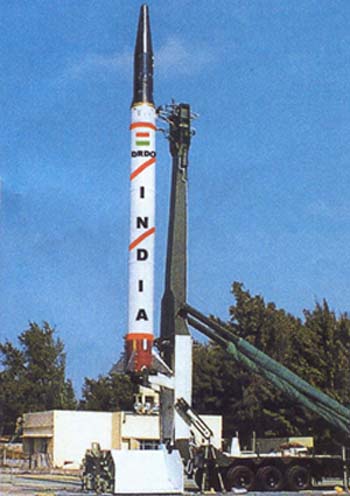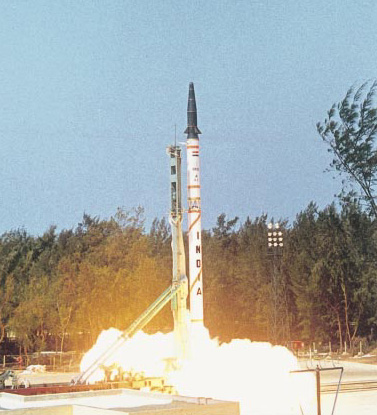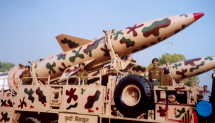INDIA
DEFENCE CONSULTANTS
|
WHAT'S
HOT? –– ANALYSIS OF RECENT HAPPENINGS |
|
|
AGNI-I JOINS INDIA'S NUCLEAR ARSENAL An IDC Analysis
|
|
|
New
Delhi, 14 April 2002 India's Nuclear Arsenal and ORBAT have never been clarified and therefore IDC had done an analysis when Agni-I was fired successfully from the Interim Test Range Balasore on 25th January, a day before Republic Day 2002. To achieve deterrence India has to show off its capability for a retaliatory strike, which can be mobile or air launched and in due course sea launched. Now India has the capability of having a Road Transportable 800km missile with a nuclear warhead in the Agni-I. Our analysis on the Prithivi, which was a missile manufactured by DRDO and all experts had opined that it was not feasible to fit a nuclear warhead on this liquid fuelled 200 km range missile. This missile did not fit into any tactical posture in the non-nuclear configuration as its CEP had to be improved. Now 65 year old Dr. K Santhanan who was a young RAW operative and had studied nuclear physics but had joined DRDO over 20 years ago and steered most programs including the nuclear blasts of 1998 under the code name Shaktihas, has written about Agni-I. His commentary in Strategic Analysis is very educative as it explains how in June 1999, Jaswant Singh, the External Affairs Minister and George Fernandes the Raksha Mantri, decided to cover the gap between Prithvi and Agni-II missiles. It would appear there was no particular plan till then for producing a range of air launched and surface launched Nuclear Bombs and Missiles for India’s Strategic Force and the command and control was being argued out with the IAF Chief A Y Tipnis pitching for it. IDC
congratulates the 2 ministers for the thoughts of 1999 and DRDO for
producing the Missile, which has a mixture of solid and liquid
propellants. The last line of the article recommending immediate
induction of Agni-1 is very relevant and the Services must have
taken note of this. Dr. K. Santhanan now the Director of IDSA was
present for the Agni-1 launch at Balasore with RM and other Senior
Armed Forces Officers. It's now clear that Agni-1 will form India's
retaliatory nuclear strike, as India has a no first use policy. Agni-I
and National Security by
K. Santhanan The
successful launch of the Agni-I missile with a range of 800–900 km
from the Interim Test Range, Balasore on January 25, 2002 has
important significance for operational aspects of our deterrence
posture. The existence of the Agni-1 project has not been generally
known outside expect for a small, select group in Government. The
first three Agni flights were in the 'technology development and
demonstration' category to acquire and master indigenous expertise
in areas like re-entry, multi-stage propulsion and related guidance
technologies. This early Agni was a hybrid,: a solid propellant
first stage and a liquid propellant second stage. It led to the
operational (and deliverable) version Agni-2, which is an all solid
propellant missile with a range of about 2,500 km. After two
consecutive and successful flight trials, the rail mobile Agni-2 has
entered the production and induction phase. The Third member of the
family, Agni-3, is in the development phase. It would also be
rail-mobile with a range of 3,500–4000 km. Its first test may
occur in late 2003. In
June 1999 Shri Jaswant Singh, EAM and Shri George Fernandes, RM
initiated a discussion on the need for a missile to cover the range
gap between the Prithvi-II (250 km) and Agni-2 (2,500 km). The go
ahead signal to develop, test and produce the Agni-1 came in October
1999. The fact that from 'go-ahead' to first flight has taken just
15 months would indicate that proven technologies and sub-system
from the Agni-2 project would have been optimally used to reduce
development efforts and speed up hardware realisation, indigenously.
Information
released by DRDO appears to confirm this surmise. Possibly, the
first stage and the re-entry vehicle of the Agni-2 have been used
with some modifications in the Agni-1. But that wouldn't be enough.
A new closed loop guidance scheme for the atmospheric phase of the
missile's trajectory would be needed. Also, some re-work of the
air-frame and sub-assemblies would be necessary because of 2–3
times higher boost phase acceleration expected for Agni-1 in
comparison to Agni-2. Realising
design and manufacturer of a new road mobile launcher for this
missile, again in 15 months, is noteworthy because it confers
operational advantages (e.g. survivability) in movement, deployment
and launch. The
discussions initiated by RM in June 1999 and the 'go ahead' of
October 1999 were against the backdrop of the Kargil war and the
nuclear shadow. Given India's ‘No First Use' doctrine and
Pakistan's NATO-like adherence to First Use, some strategists in
India had the perception that Prithvi deployment, even with
conventional warheads would provoke Pakistan to undertake a
pre-emptive nuclear strike because "Pakistan may perceive the
Prithvi as deployed with nuclear warheads". This theory led to
an assertion that the Prithvi deployment would lower the nuclear
threshold. Further, given the short range of the Prithvi, its
movement from storage depots to launch points would be tracked by
Pak intelligence. It
is known that, from its inception, the Prithvi was designed to carry
conventional warheads, like pre-fragmented monolith and bomblet
sub-munitions. However, until June 1999, no serious direction seems
to have been given to DRDO by the Service or the Government, on the
inevitable need for a nuclear missile, which could be launched
sufficiently far away from the western border. The
road mobile, solid propellant Agni-1 (800–900 km) urgently fills
this missile gap. But the fact that the Agni-1 was taken as a crash
project only in June 1999 indicates the reactive nature of our
procedures and processes. The
Services would be well advised to immediately initiate action for
training, induction and maintenance of the Agni-1, with speed equal
to that shown by DRDO. |
Agni-I -- Medium range ballistic missile (800-900 km)
Agni-II -- Intermediate range ballistic missile (2500 km) BrahMos -- Intermediate range supersonic cruise missile.
Prithvi -- Short range ballistic missile (250 km) Dhanush -- Naval variant of Prithvi missile (250 km)
|


